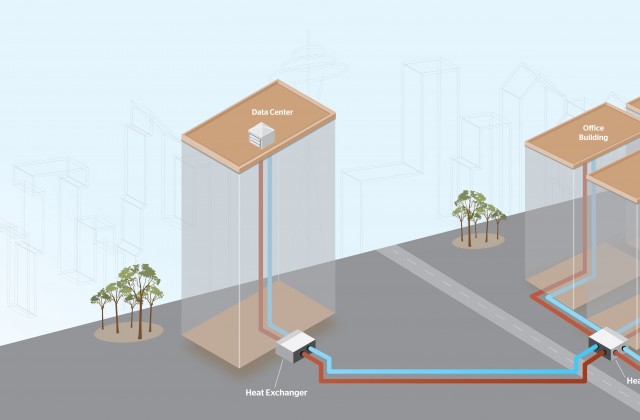City Builder:Generating a Lot of Heat
Seattle is known for its fair share of eco-friendly solutions—green building, hydro-power, recycling, rain gardens, electric taxis, green roofs and composting come to mind. But McKinstry, always on the lookout to improve buildings’ systems efficiency, has implemented a new idea to solve an old problem by reusing the waste heat of a private colocation data facility to heat the offices of another corporation.
The Westin Building Exchange is the home to a large data center owned and managed by long-time McKinstry client Clise Properties. Data centers—the storehouses of row upon row of servers that make our daily lives possible—are notorious for expelling sirocco-like waves of heat. It’s a problem for the data centers because a lot of energy is needed to run these servers and a lot of energy and water is also needed to cool them off. This equates to a lose-lose situation for the environment, but a clear win for corporations and consumers who rely on the capacity of the data center for business as usual.
The heat generated by the Westin Building Exchange’s servers was not only going to waste, but also requiring the use of more energy to keep things cool. That’s where McKinstry and Clise started looking for ways to recycle the energy and heat that was being expelled by one system for use in another.
And then Amazon revealed plans to move across the street, and the stars aligned.
McKinstry has long been a proponent of reusing energy. It’s not only a part of their service offerings, they also walk the talk. In fact, the company’s local office reuses heat generated by their own data center to heat their onsite deli.
So where Clise connected the dots, McKinstry provided the solution; and together, the two companies created the 21st century version of an energy district between two high-rises in downtown Seattle—a first in itself.
Jeff Sloan, design manager and brains behind the technical solution, and Patrick Farley, head of McKinstry Capital who headed up the negotiations side of things, teamed up to arrive at the ultimate solution[SP3] . Here’s how it works: The heat put off by the data center is collected via the water in the cooling tower by a heat exchanger. It will then be piped underground to Amazon’s newest campus across the street to a heat recovery chiller and used to heat the building. Once the heat has been recovered, the water returns back underground to the Westin data center, where the process repeats ad infinitum.
It’s an all-around win. The Westin saves money in energy and water use, while Amazon saves about three-quarters on their utility bills for heating and gains an incentive from the utility companies. The utility companies, in turn, can sell the conserved energy and gas to other entities. And best of all, the environment takes less of a hit.
Looking at the bottom-line, developers, building owners and architects also comes out on top. From a Total Cost of Ownership standpoint, using the waste heat is more economically beneficial than other alternative solutions, and enables designers to take more creative liberties to incorporate modern design features and materials.
According to Sloan and Farley of McKinstry, data centers can now be energy resources and not just energy users. It’s a great example of private industry coming together with local government and innovating to forward the best interests of the community through environmental stewardship.



